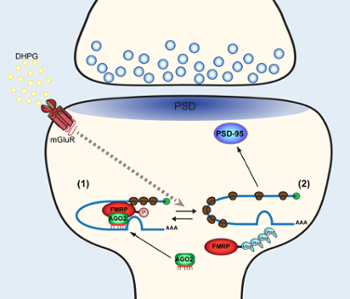Molecular mechanism of FMRP mediated regulation of local protein synthesis and dysregulation in fragile x syndrome
Several studies have shown that FMRP can repress translation of its mRNA targets through different mechanisms, although it was unclear how FMRP mediated repression might be relieved to allow for local protein synthesis at synapses. We hypothesized that FMRP cooperates with RISC/microRNAs to reversibly regulate mRNA translation at synapses in response to glutamatergic signaling. We uncovered a novel molecular mechanism whereby the phosphorylation status of FMRP acts as sensor to recruit or expel RISC/microRNA in response to mGluR activation (Muddashetty et al., Molecular Cell). Phosphorylated FMRP, which represses translation of PSD-95 mRNA, is strongly associated with Ago2/miR-125a. Activation of gp 1 mGluR receptors leads to FMRP dephosphorylation, loss of Ago2/miR-125a association with PSD-95 mRNA and increased translation. This work further motivates the hypothesis that loss of RISC mediated silencing of mRNA translation at synapses may broadly contribute to dysregulated translation in FXS. Prior to this study, we reported dysregulated translation of PSD-95 mRNAs at synapses in a mouse model of FXS (Muddashetty et. al. Journal of Neuroscience 2007). We further identified a role for mGlu-induced ubiquitination of FMRP locally within dendrites as an additional means to remove translational repression by FMRP (Nalavadi et al., Journal of Neuroscience 2012). Our most recent work has used single molecule imaging of a fluorescent translation reported to demonstrate the role of FMRP and miR-125a in regulation of local translation of PSD-95 mRNA in dendrites and spines and its dysregulation in the mouse model of fragile x syndrome (Ifrim et al., Journal of Neuroscience 2015).
 Proposed model: FMRP cooperation with microRNAs at the synapse reversibly regulates local protein synthesis of postsynaptic components. 1) Translational repression: FMRP binds near microRNA target site. Phosphorylated FMRP recruits RISC/miR complex to target sequence to repress translation; 2) Translation activation by gp 1 mGlu receptors involves FMRP dephosphorylation by PP2A, FMRP ubiquitination, loss of RISC/miR association with target mRNA, and removal of translational repression. Local synthesis of PSD-95 and Shank1 are regulated in this manner. Untargeted MicroRNAs may underlie dysregulated translation in FXS. (Ifrim et al., Journal of Neuroscience 2015)
Proposed model: FMRP cooperation with microRNAs at the synapse reversibly regulates local protein synthesis of postsynaptic components. 1) Translational repression: FMRP binds near microRNA target site. Phosphorylated FMRP recruits RISC/miR complex to target sequence to repress translation; 2) Translation activation by gp 1 mGlu receptors involves FMRP dephosphorylation by PP2A, FMRP ubiquitination, loss of RISC/miR association with target mRNA, and removal of translational repression. Local synthesis of PSD-95 and Shank1 are regulated in this manner. Untargeted MicroRNAs may underlie dysregulated translation in FXS. (Ifrim et al., Journal of Neuroscience 2015)
